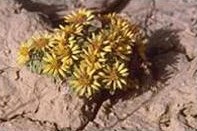
Lasthenia burkei is a rare species of flowering plant in the family Asteraceae known by the common names Burke's goldfields and Burke's baeria.
Blennosperma bakeri is a rare species of flowering plant in the daisy family known by the common names Baker's stickyseed and Sonoma sunshine.
Pseudobahia bahiifolia is a rare species of flowering plant in the family Asteraceae known by the common name Hartweg's golden sunburst.
Pseudobahia peirsonii is a rare species of flowering plant in the family Asteraceae known by the common names San Joaquin adobe sunburst and Tulare pseudobahia. It is endemic to California, where it is known from a few mostly small occurrences along the southeastern side of the San Joaquin Valley where it rises into the Sierra Nevada foothills. It grows in grassland and oak woodland habitat. It prefers heavy adobe clay soils. The plant became a federally listed threatened of the United States in 1997.

Raillardella pringlei is an uncommon species of flowering plant in the family Asteraceae known by the common name showy raillardella. It is endemic to the southern Klamath Ranges of northern California, where it grows in moist forest habitat on serpentine soils. It is a rhizomatous perennial herb growing in a clump of rosetted basal leaves. The leaves are linear to lance-shaped with smooth or faintly toothed edges, up to 15 centimeters long, and mostly hairless. The plant produces an inflorescence generally 25 centimeters to half a meter tall consisting of a solitary flower head or an array of up to three heads. The head is bell-shaped, sometimes widely so. It contains many orange to red-orange disc florets each about a centimeter long, and a fringe of several orange or reddish ray florets each up to 2 centimeters in length. The fruit is a long, narrow achene which may be 2 centimeters in length including its pappus of plumelike bristles.
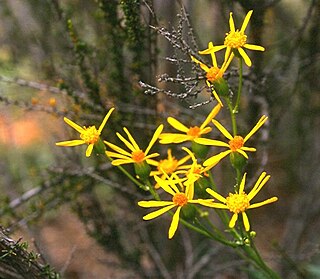
Packera layneae, known by the common name Layne's ragwort and Layne's butterweed, is a rare species of flowering plant in the aster family.

Townsendia condensata is a species of flowering plant in the family Asteraceae known by the common names cushion Townsend daisy and cushion townsendia. It is native to North America where it is known from many scattered occurrences in the mountains of the western United States and Alberta in Canada. It is mainly limited to the alpine climates of high mountain peaks, where it grows in meadows, tundra, and barren, rocky talus. It grows alongside other alpine plants such as Eriogonum androsaceum.
Townsendia leptotes is a species of flowering plant in the family Asteraceae known by the common names common Townsend daisy and slender townsendia. It is native to the western United States, where it grows in the alpine climates of high mountain ranges from California to Montana to New Mexico.

Townsendia scapigera is a species of flowering plant in the family Asteraceae known by the common name tufted Townsend daisy. It is native to the western United States, where it grows in mountains, sagebrush, and other habitat.

Erigeron rhizomatus is a rare species of flowering plant in the aster family known by the common names Zuni fleabane and rhizome fleabane. It is native to western New Mexico and eastern Arizona in the United States. It is a federally listed threatened species.
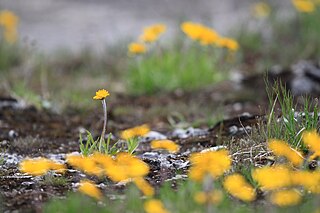
Tetraneuris herbacea is a rare species of flowering plant in the aster family known by the common names eastern fournerved daisy, lakeside daisy, fournerved starflower, and Manitoulin gold. It is native to and endemic to the Great Lakes region in North America, where it is present in Ontario, Ohio, Michigan, and Illinois. It is threatened by habitat destruction and degradation by several forces, including limestone quarrying, recreational activity, fire suppression, and construction. It is a federally listed threatened species of the United States and of Canada.
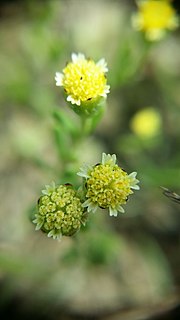
Hymenoxys texana is a rare species of flowering plant in the aster family known by the common names prairie dawn, Texas prairie dawn-flower, and Texas bitterweed. It is endemic to Texas, where it is known only from the general vicinity of Houston. It is threatened by the loss of its habitat. It is a federally listed endangered species of the United States.
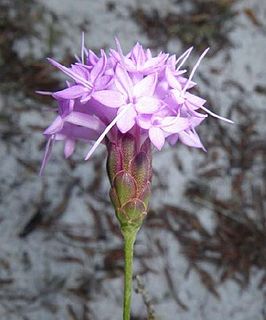
Liatris ohlingerae is a rare species of flowering plant in the family Asteraceae known by the common names Florida blazing star, Florida gayfeather, scrub blazing star, and sandtorch. It is endemic to Florida in the United States, where it occurs only on the Lake Wales Ridge along with many other rare plants. It is threatened by the loss and degradation of its habitat, and it is federally listed as an endangered species.

Pediocactus despainii is a rare species of cactus known by the common names Despain's cactus and San Rafael cactus. It is endemic to the state of Utah in the United States, where it is limited to the San Rafael Swell in Emery County, Utah.
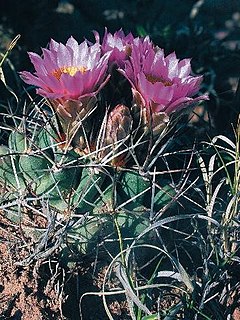
Sclerocactus glaucus is a rare species of cactus known by the common name Colorado hookless cactus. It is endemic to Colorado in the United States, where it is known only from the area between Grand Junction and Montrose. It is a federally listed threatened species.
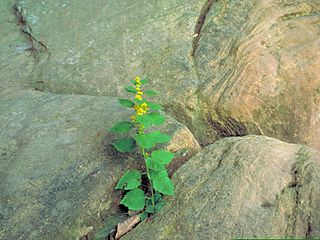
Solidago albopilosa is a rare species of flowering plant in the aster family known by the common name whitehair goldenrod.
Tetramolopium arenarium is a rare species of flowering plant in the aster family known by the common name Maui tetramolopium. It is endemic to Hawaii, where it is known only from the island of Hawaii. It is extirpated from Maui. It is threatened by the degradation of its habitat. It is a federally listed endangered species of the United States.
Thymophylla tephroleuca is a rare species of flowering plant known by the common names ashy pricklyleaf and ashy dogweed. It is endemic to Texas in the United States, where it occurs in two counties near the Mexican border. It became rare due to the destruction and degradation of its habitat. It is a federally listed endangered species of the United States.
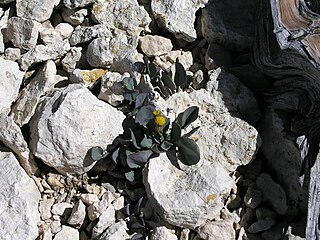
Packera malmstenii is a rare species of flowering plant in the aster family known by the common name Podunk ragwort. It is endemic to Utah in the United States, where there about 19 occurrences in the southwestern part of the state.
Thelesperma pubescens is a species of flowering plants in the aster family known by the common names hairy greenthread and Uinta greenthread. It is native to Wyoming and Utah in the United States. This species was first described in 1983.
